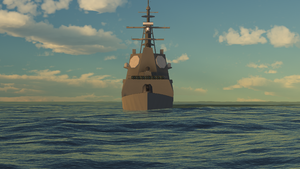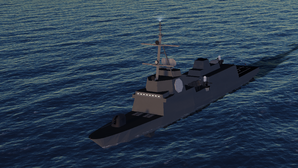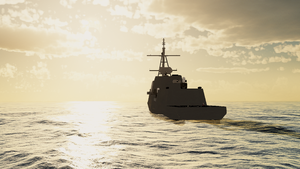Klaes-Haydn Class Cruiser: Difference between revisions
(Created page with "The '''Klaes-Haydn Class Cruiser''' is a class of guided-missile cruisers currently in service in the Imperial Union. While initially designed as an Air Warfare Destroyer, the scope of the project quickly evolved into a much more capable multi-role platform to complement the existing Prometheus-Class AAW Destroyer and the Warspite-Class Cruisers.{{Craft |name = Klaes Haydn-Class Cruiser |full_name = Klaes Haydn-Class Air Warfare Cruiser |image = a|imagedesc = HMS...") |
No edit summary |
||
| Line 2: | Line 2: | ||
|name = Klaes Haydn-Class Cruiser |
|name = Klaes Haydn-Class Cruiser |
||
|full_name = Klaes Haydn-Class Air Warfare Cruiser |
|full_name = Klaes Haydn-Class Air Warfare Cruiser |
||
| − | |image = |
+ | |image = Screenshot224.png|imagedesc = HMS Klaes-Haydn in her maiden voyage |
|type=Ship |
|type=Ship |
||
|role=Primary Fleet Air Defence |
|role=Primary Fleet Air Defence |
||
| Line 34: | Line 34: | ||
The Klaes-Haydn Class is the Imperial Union's first non-capital ship to be christened after an individual, being named after Westrayan [[Admiral Klaes Haydn]], who has achieved near-legendary status in the empire's Kafrican territories for his valiant actions in protecting Vocavian refugees whom has escaped from the Avalonian menace across the Vocavian Sea. |
The Klaes-Haydn Class is the Imperial Union's first non-capital ship to be christened after an individual, being named after Westrayan [[Admiral Klaes Haydn]], who has achieved near-legendary status in the empire's Kafrican territories for his valiant actions in protecting Vocavian refugees whom has escaped from the Avalonian menace across the Vocavian Sea. |
||
==Design and Armament== |
==Design and Armament== |
||
| + | [[File:Screenshot223.png|left|thumb|Frontal view of the HMS Soroner. The unusually high placement of the CRYSTAL system can be noted.]] |
||
| − | + | [[File:Screenshot219.png|left|thumb|298x298px|Lead ship HMS ''Orion'' under-going sea trials, 2189]]As a next-generation surface combatant geared for escort and patrol duties, the Orion-class incorporated a wide range of new Imperial technology that pioneered their use on other vessels through out the Imperial Armed Forces. One noteworthy example is the inclusion of a reinforced keel for greater ASW effectives and survivability in case of a torpedo hit to the keel. While traditional keels would succumb to even indirect detonation, the newly introduced reinforcements will allow current and future Orion frigates to be combat-effective even after a direct torpedo hit. |
|
Froston Industries' CRYSTAL system saw its first deployment on the Orions, with two arrays being mounted on the sides of the superstructure aft of the main bridge. While it does not provide full coverage of the combat area, the two arrays combined with secondary SIMPSON radar and illuminators enable long-range tracking of up to 16 enemy contacts, a marked increase from the preceeding Acheron Class. Crew and technical data garnered from the radar systems onboard the lead ship HMS Orion during its initial combat trials allowed researchers at FROSTON Industries and VAE Shipyards to perfect system and software integration for their upcoming Future Air Warfare Destroyer/Cruiser project. |
Froston Industries' CRYSTAL system saw its first deployment on the Orions, with two arrays being mounted on the sides of the superstructure aft of the main bridge. While it does not provide full coverage of the combat area, the two arrays combined with secondary SIMPSON radar and illuminators enable long-range tracking of up to 16 enemy contacts, a marked increase from the preceeding Acheron Class. Crew and technical data garnered from the radar systems onboard the lead ship HMS Orion during its initial combat trials allowed researchers at FROSTON Industries and VAE Shipyards to perfect system and software integration for their upcoming Future Air Warfare Destroyer/Cruiser project. |
||
Revision as of 14:29, 8 June 2024
The Klaes-Haydn Class Cruiser is a class of guided-missile cruisers currently in service in the Imperial Union. While initially designed as an Air Warfare Destroyer, the scope of the project quickly evolved into a much more capable multi-role platform to complement the existing Prometheus-Class AAW Destroyer and the Warspite-Class Cruisers.
|
Klaes Haydn-Class Cruiser
Klaes Haydn-Class Air Warfare Cruiser
|
|||||
|---|---|---|---|---|---|
| Ship | |||||
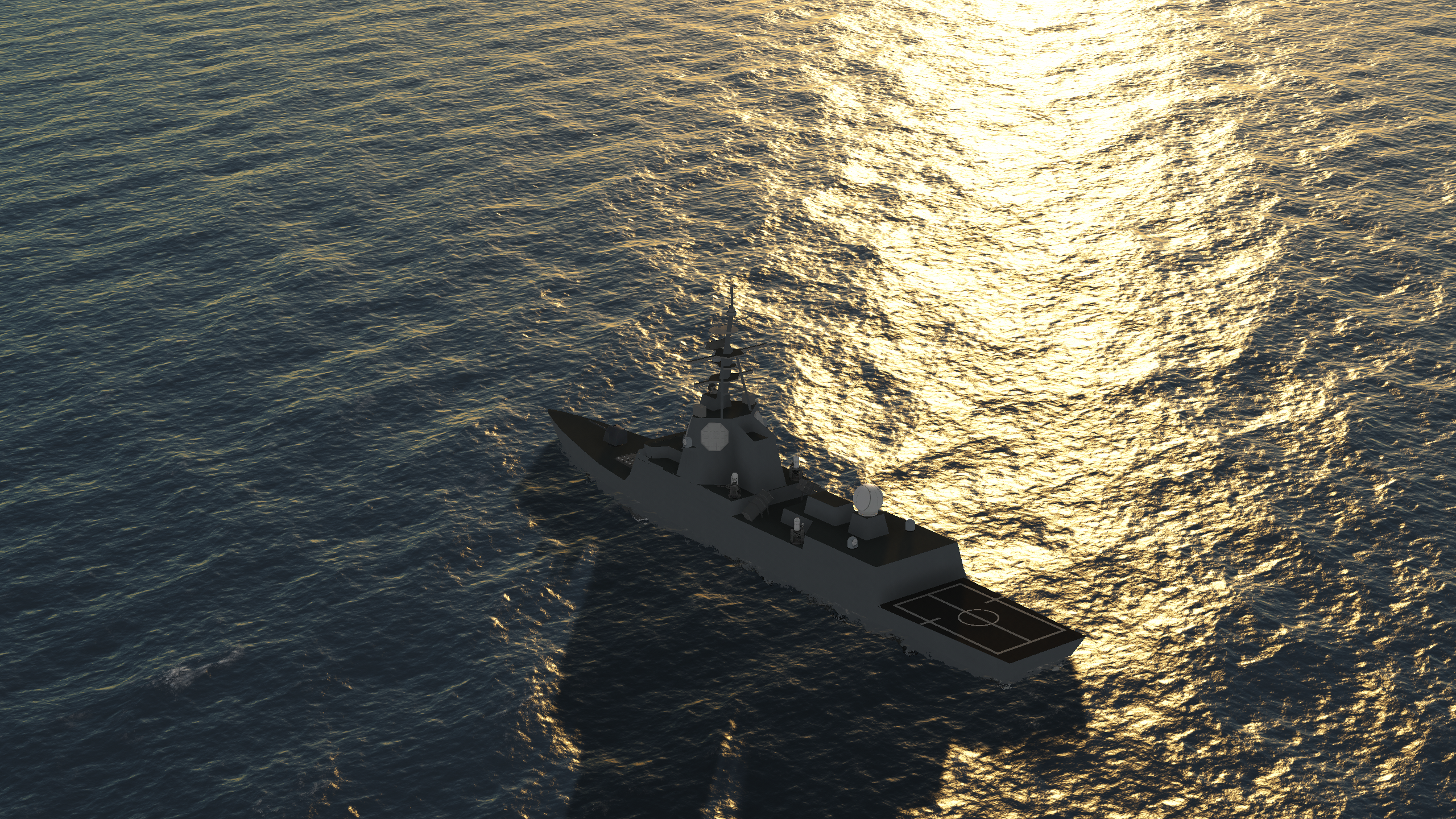 |
|||||
| HMS Klaes-Haydn in her maiden voyage | |||||
| Role | Primary Fleet Air Defence | ||||
| National Origin | Imperial Union | ||||
| Production History | |||||
| Produced | |||||
| 2193 - ongoing | |||||
| Designer | VAE Shipyards | ||||
| Unit Cost | 400,000(√) | ||||
| Number Built | 3, 7 on order | ||||
| Service History | |||||
| In Service | |||||
| 2194 - ongoing | |||||
| Used By | Imperial Union Imperial Royal Navy | ||||
| Vessel Characteristics | |||||
| Displacement | 3000 Tons | ||||
| Length | 110 m | ||||
| Beam | 16 m | ||||
| Height | 26 m | ||||
| Draft | 5 m | ||||
| Propulsion | x4 FROSTON Electro Propulsion | ||||
| Max Speed | 29 kn (14.5 m/s) | ||||
| Operational Range | 1800 km | ||||
| Complement | 330 (30 officers, 300 enlisted) | ||||
| Sensors and Processing Systems | FROSTON CRYSTAL Block II |
||||
| Armament | x1 127mm Naval gun x6 Phalanx CIWS x5 250MW Lazer |
||||
| Boats Carried | x1 25ft Swiftboat | ||||
Development
The Klaes Haydn-Class began development in 2193 following the success of the Orion-Class Frigate as an evolution of the Air Warfare Destroyer Program to satisfy the IRN's demand for a large AAW cruiser capable of leveraging the newly developed FROSTON CRYSTAL system. Unlike the VSD's affordable frigate design, the Klaes Haydn was designed from the very start without any form of cost-ceiling. This was mainly due to the IRN and the wider armed force's restructuring and drastically increased defence spending under the Imperial Union's New Century Rearmament Act, granting the nation's armed forces close to 50% additional funding incrementally provided over 10 years. As such, the IRN's demand for the new cruiser was expanded upon the already ambitious design to include extensive anti-surface capabilites akin to the IRN's aging Warspite Class. The revised design was submitted for approval in late 2193 and was approved for production before the end of the year.
The Klaes-Haydn Class is the Imperial Union's first non-capital ship to be christened after an individual, being named after Westrayan Admiral Klaes Haydn, who has achieved near-legendary status in the empire's Kafrican territories for his valiant actions in protecting Vocavian refugees whom has escaped from the Avalonian menace across the Vocavian Sea.
Design and Armament
As a next-generation surface combatant geared for escort and patrol duties, the Orion-class incorporated a wide range of new Imperial technology that pioneered their use on other vessels through out the Imperial Armed Forces. One noteworthy example is the inclusion of a reinforced keel for greater ASW effectives and survivability in case of a torpedo hit to the keel. While traditional keels would succumb to even indirect detonation, the newly introduced reinforcements will allow current and future Orion frigates to be combat-effective even after a direct torpedo hit.
Froston Industries' CRYSTAL system saw its first deployment on the Orions, with two arrays being mounted on the sides of the superstructure aft of the main bridge. While it does not provide full coverage of the combat area, the two arrays combined with secondary SIMPSON radar and illuminators enable long-range tracking of up to 16 enemy contacts, a marked increase from the preceeding Acheron Class. Crew and technical data garnered from the radar systems onboard the lead ship HMS Orion during its initial combat trials allowed researchers at FROSTON Industries and VAE Shipyards to perfect system and software integration for their upcoming Future Air Warfare Destroyer/Cruiser project.
One of the most obvious changes made from VSD's intial proposal is the marked increase in maximum speed. While the original design was projected to reach a maximum speed of 20 knots using traditional disel-electric propulsion, the IRN demanded the ship be capable of reaching 30 knots in order to keep up with Imperial Carrier fleets. To accomodate for this demand, VAE Shipyards replaced their traditional propulsion-power system with Froston Industries' Electric Propulsion Motor Mk3 and a M1800 Gas Turbine generator. Although slightly more costly than their traditional counterparts, it was discovered in HMS Orion's maiden voyage that the new systems were far more efficient and reliable in long-term operations, prompting the IRN to investigate the possibitilies of refitting major combatants to utilise the new technology.
The frigate also boasts an impressive arsenal for its size with 48 VLS cells fore of the bridge, one 57mm naval gun, one SeaRAM launcher, two Phalanx CIWS systems and two 4 cell AshM launchers located amidships. In its standard escort configuration the VLS cells are designed to accomodate ESSM medium range interceptor missiles but they are also able to be outfitted with RIM-66 long-range interceptors or a limited range of cruise missiles to supplement the 8 AshMs stored in box launchers.
Another noteworthy feature of the Orion-class is the large mission bay located amidships. Despite the frigate's small size, the mission bay is able to accomodate up to two K-53B II VTOL Fighters or ASW Helicopters as well as two BIMO (Boat, Inflatable, Multi-service Operational) high-manouverability boats, giving the Orion its characteristic mission flexibility.
Contract Award and Foreign Sales
In November 2186, VAE Shipyards was awarded with a 1.5M Kredit contract by the IRN to produce 5 frigates with an option for 15 additional frigates after the intial delivery. However, following the ship's stellar performance during its maiden voyage and combat trials that far exceeded application, the order was expanded to 5+20, all expected to be delivered by the end of 2201.
Both the Confederate Coast Guard and Navy expressed interest in the frigate even during its design phase at VSD. The frigate's cost-effectiveness combined with its large mission bay made it a strong contender for the two service's future combatant program, and by 2187, contracts for 10 frigates from the Coast Guard and 8 for the Navy were awarded to VAE Shipyards. All 18 frigates were delivered and are in active service under the two services.
Service History
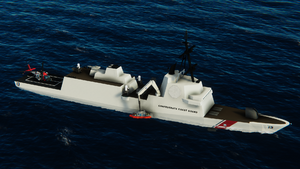
N/A
